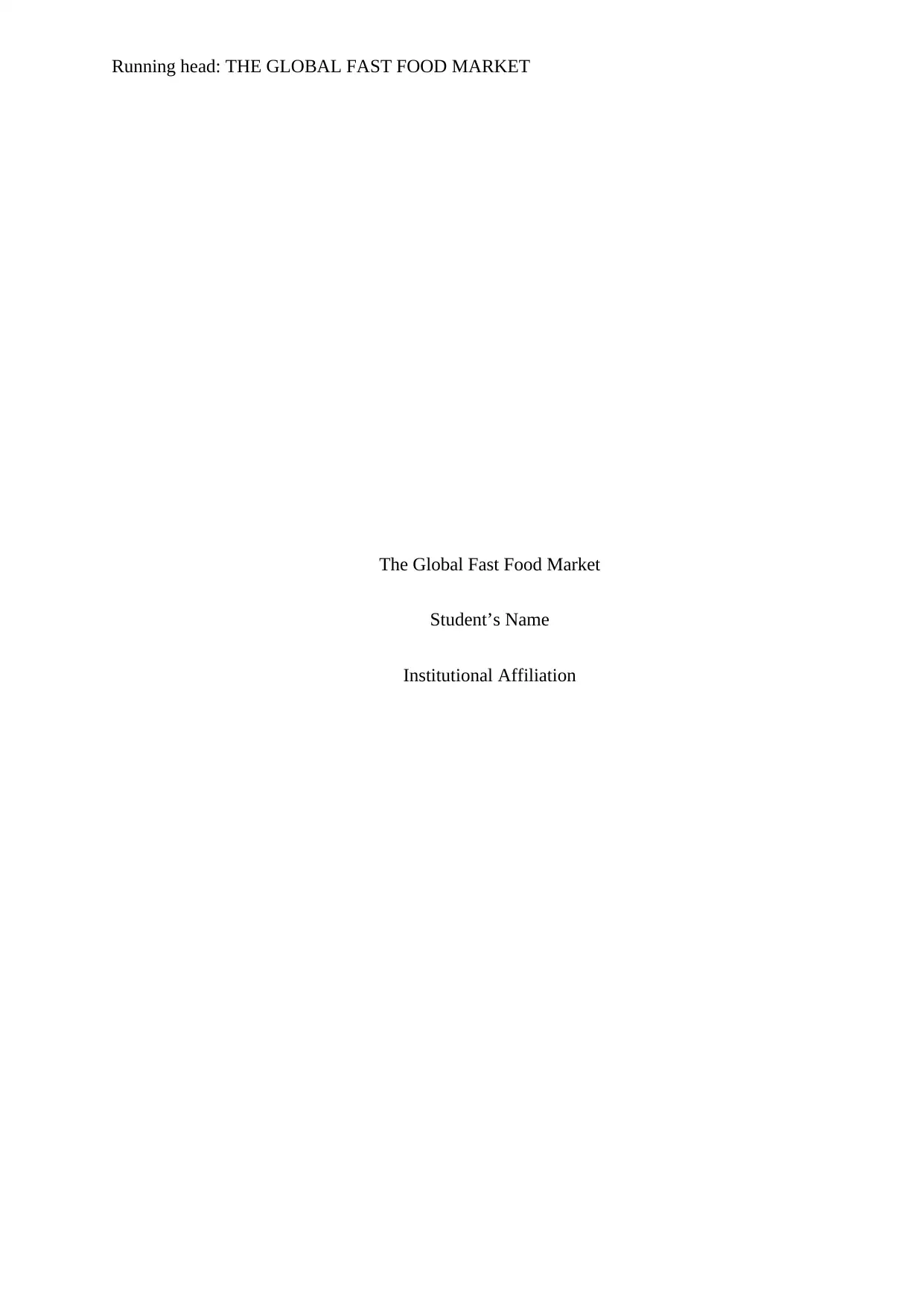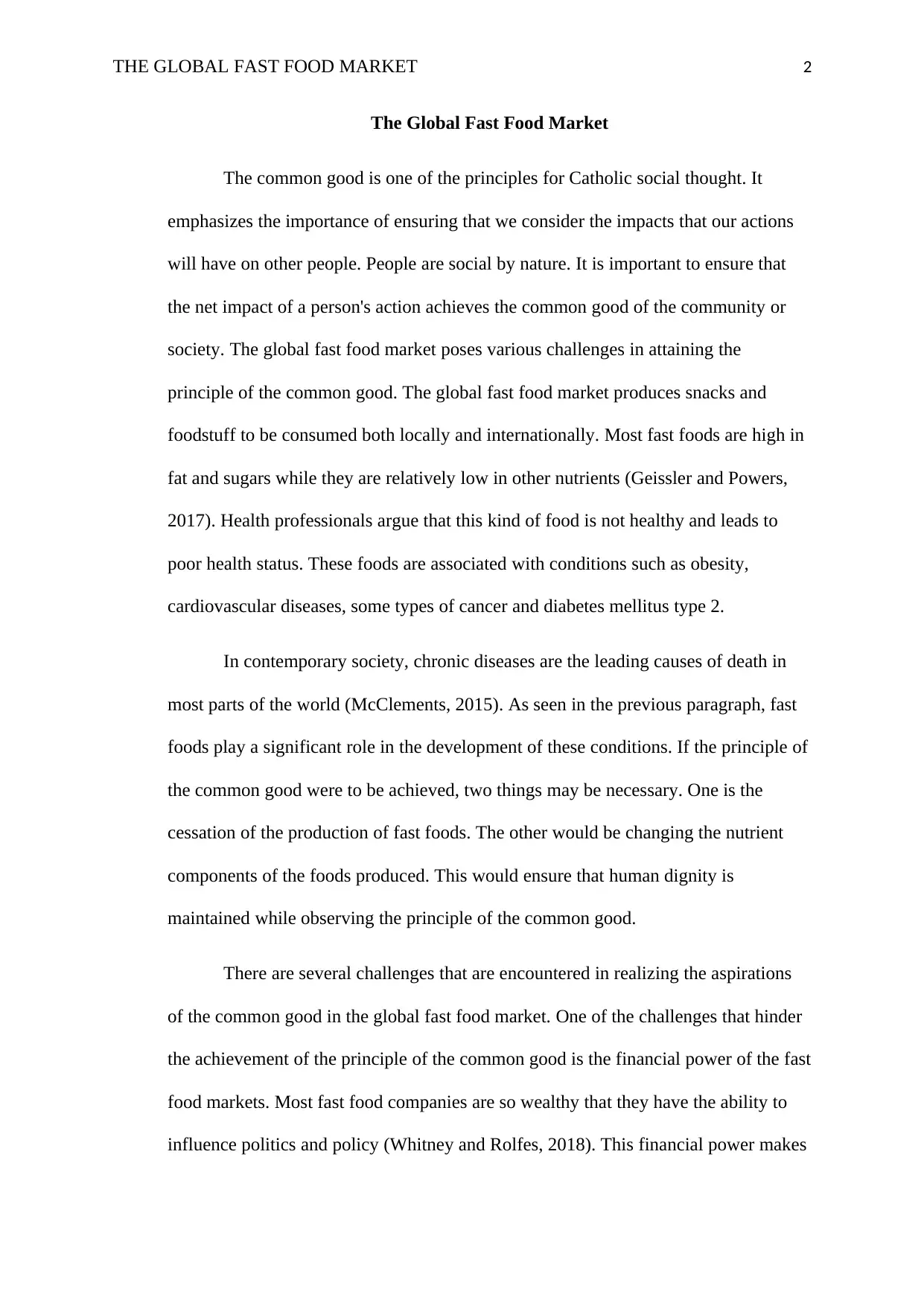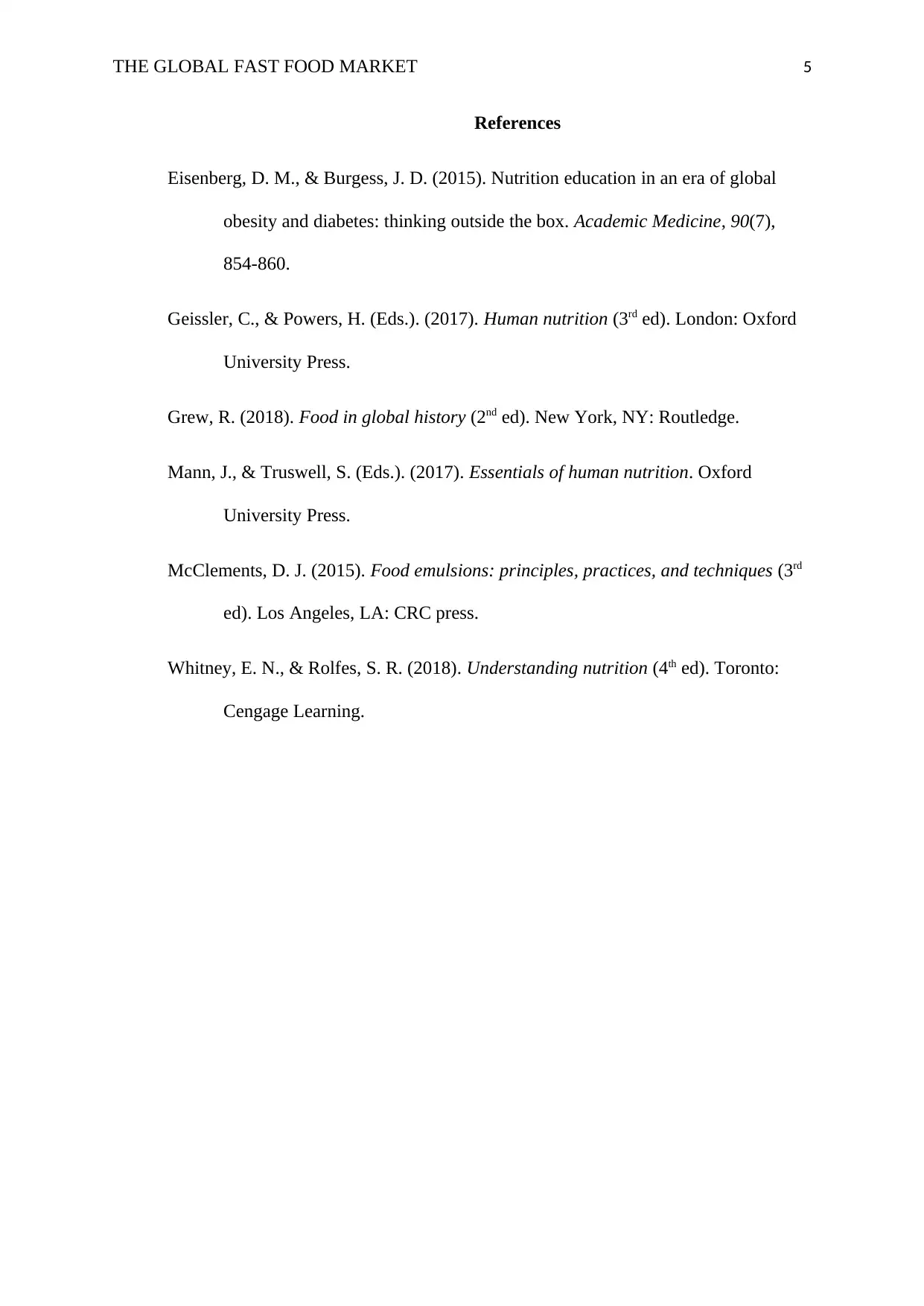The Global Fast Food Market's Impact and Challenges Analysis
VerifiedAdded on 2023/01/23
|5
|1022
|44
Essay
AI Summary
This essay explores the global fast food market and its challenges in relation to the principle of the common good, focusing on the impact on public health. The essay highlights that fast foods are often high in fat and sugar, contributing to chronic diseases like obesity and diabetes. Challenges to achieving the common good include the financial power of fast food companies influencing policies, the westernization of diets promoting unhealthy eating habits, and a lack of knowledge about healthy dietary choices. The essay emphasizes the need to consider the broader societal impacts of the fast food industry to promote human dignity and the common good, discussing potential solutions such as modifying food nutrient components and addressing financial influence.

Running head: THE GLOBAL FAST FOOD MARKET
The Global Fast Food Market
Student’s Name
Institutional Affiliation
The Global Fast Food Market
Student’s Name
Institutional Affiliation
Paraphrase This Document
Need a fresh take? Get an instant paraphrase of this document with our AI Paraphraser

THE GLOBAL FAST FOOD MARKET 2
The Global Fast Food Market
The common good is one of the principles for Catholic social thought. It
emphasizes the importance of ensuring that we consider the impacts that our actions
will have on other people. People are social by nature. It is important to ensure that
the net impact of a person's action achieves the common good of the community or
society. The global fast food market poses various challenges in attaining the
principle of the common good. The global fast food market produces snacks and
foodstuff to be consumed both locally and internationally. Most fast foods are high in
fat and sugars while they are relatively low in other nutrients (Geissler and Powers,
2017). Health professionals argue that this kind of food is not healthy and leads to
poor health status. These foods are associated with conditions such as obesity,
cardiovascular diseases, some types of cancer and diabetes mellitus type 2.
In contemporary society, chronic diseases are the leading causes of death in
most parts of the world (McClements, 2015). As seen in the previous paragraph, fast
foods play a significant role in the development of these conditions. If the principle of
the common good were to be achieved, two things may be necessary. One is the
cessation of the production of fast foods. The other would be changing the nutrient
components of the foods produced. This would ensure that human dignity is
maintained while observing the principle of the common good.
There are several challenges that are encountered in realizing the aspirations
of the common good in the global fast food market. One of the challenges that hinder
the achievement of the principle of the common good is the financial power of the fast
food markets. Most fast food companies are so wealthy that they have the ability to
influence politics and policy (Whitney and Rolfes, 2018). This financial power makes
The Global Fast Food Market
The common good is one of the principles for Catholic social thought. It
emphasizes the importance of ensuring that we consider the impacts that our actions
will have on other people. People are social by nature. It is important to ensure that
the net impact of a person's action achieves the common good of the community or
society. The global fast food market poses various challenges in attaining the
principle of the common good. The global fast food market produces snacks and
foodstuff to be consumed both locally and internationally. Most fast foods are high in
fat and sugars while they are relatively low in other nutrients (Geissler and Powers,
2017). Health professionals argue that this kind of food is not healthy and leads to
poor health status. These foods are associated with conditions such as obesity,
cardiovascular diseases, some types of cancer and diabetes mellitus type 2.
In contemporary society, chronic diseases are the leading causes of death in
most parts of the world (McClements, 2015). As seen in the previous paragraph, fast
foods play a significant role in the development of these conditions. If the principle of
the common good were to be achieved, two things may be necessary. One is the
cessation of the production of fast foods. The other would be changing the nutrient
components of the foods produced. This would ensure that human dignity is
maintained while observing the principle of the common good.
There are several challenges that are encountered in realizing the aspirations
of the common good in the global fast food market. One of the challenges that hinder
the achievement of the principle of the common good is the financial power of the fast
food markets. Most fast food companies are so wealthy that they have the ability to
influence politics and policy (Whitney and Rolfes, 2018). This financial power makes

THE GLOBAL FAST FOOD MARKET 3
it difficult for the fast food industries to be banned. There also exists evidence that
fast food industries use this financial power to their advantage. For instance, they may
fund such health agencies as the World Health Organization. Therefore, these
agencies may not discriminate or say negative things about fast foods. The fast food
industries may also fund research and make the results biased so that the results show
the advantages of their food products. Therefore, the financial power of the fast food
industries poses a great challenge in the achievement of the principle of the common
good.
Westernization of diet is another challenge. In modern society, almost every
country of the world has emulated the western culture including dietary habits. The
western diet is very poor in nutrients while rich in fat and sugar (Mann and Truswell,
2017). Fat and sugar are two food components that are implicated in the development
of most chronic illnesses. Westernization of diet has made most people believe that
the western diet is superior to their own (Grew, 2018). The result is that most people
across the world have adopted the western culture and diet. Therefore, the fast food
market has a ready market both locally and all over the world. The global fast food
market mainly targets people who have adopted the western diet. The reason for this
targeting is because most fast food companies manufacture foods of western
civilization. In a nutshell, westernization of the diet has posed a great challenge in
averting the harmful effects caused by the global fast food market. As a result, the
principle of the common good is not achieved.
Inadequate knowledge about good dietary habits also poses a challenge.
Research has shown that most people around the world do not know what constitutes
a healthy diet (Eisenberg and Burgess, 2015). When making food choices, most
people are influenced by taste and the physical presentation of foods. Although there
it difficult for the fast food industries to be banned. There also exists evidence that
fast food industries use this financial power to their advantage. For instance, they may
fund such health agencies as the World Health Organization. Therefore, these
agencies may not discriminate or say negative things about fast foods. The fast food
industries may also fund research and make the results biased so that the results show
the advantages of their food products. Therefore, the financial power of the fast food
industries poses a great challenge in the achievement of the principle of the common
good.
Westernization of diet is another challenge. In modern society, almost every
country of the world has emulated the western culture including dietary habits. The
western diet is very poor in nutrients while rich in fat and sugar (Mann and Truswell,
2017). Fat and sugar are two food components that are implicated in the development
of most chronic illnesses. Westernization of diet has made most people believe that
the western diet is superior to their own (Grew, 2018). The result is that most people
across the world have adopted the western culture and diet. Therefore, the fast food
market has a ready market both locally and all over the world. The global fast food
market mainly targets people who have adopted the western diet. The reason for this
targeting is because most fast food companies manufacture foods of western
civilization. In a nutshell, westernization of the diet has posed a great challenge in
averting the harmful effects caused by the global fast food market. As a result, the
principle of the common good is not achieved.
Inadequate knowledge about good dietary habits also poses a challenge.
Research has shown that most people around the world do not know what constitutes
a healthy diet (Eisenberg and Burgess, 2015). When making food choices, most
people are influenced by taste and the physical presentation of foods. Although there
⊘ This is a preview!⊘
Do you want full access?
Subscribe today to unlock all pages.

Trusted by 1+ million students worldwide

THE GLOBAL FAST FOOD MARKET 4
are other factors that may be involved, the appetizing aspect of food is a great
influence. The fast-food companies know this too well. Therefore, they package their
foods in such a way that it will appear appetizing to the customer. They also make
their foods to be sweet in a bid to stimulate the taste buds of the customer to request
for more. Therefore, the lack of knowledge of a healthy diet has contributed to the
harmful effects of the global fast food market both locally and globally.
are other factors that may be involved, the appetizing aspect of food is a great
influence. The fast-food companies know this too well. Therefore, they package their
foods in such a way that it will appear appetizing to the customer. They also make
their foods to be sweet in a bid to stimulate the taste buds of the customer to request
for more. Therefore, the lack of knowledge of a healthy diet has contributed to the
harmful effects of the global fast food market both locally and globally.
Paraphrase This Document
Need a fresh take? Get an instant paraphrase of this document with our AI Paraphraser

THE GLOBAL FAST FOOD MARKET 5
References
Eisenberg, D. M., & Burgess, J. D. (2015). Nutrition education in an era of global
obesity and diabetes: thinking outside the box. Academic Medicine, 90(7),
854-860.
Geissler, C., & Powers, H. (Eds.). (2017). Human nutrition (3rd ed). London: Oxford
University Press.
Grew, R. (2018). Food in global history (2nd ed). New York, NY: Routledge.
Mann, J., & Truswell, S. (Eds.). (2017). Essentials of human nutrition. Oxford
University Press.
McClements, D. J. (2015). Food emulsions: principles, practices, and techniques (3rd
ed). Los Angeles, LA: CRC press.
Whitney, E. N., & Rolfes, S. R. (2018). Understanding nutrition (4th ed). Toronto:
Cengage Learning.
References
Eisenberg, D. M., & Burgess, J. D. (2015). Nutrition education in an era of global
obesity and diabetes: thinking outside the box. Academic Medicine, 90(7),
854-860.
Geissler, C., & Powers, H. (Eds.). (2017). Human nutrition (3rd ed). London: Oxford
University Press.
Grew, R. (2018). Food in global history (2nd ed). New York, NY: Routledge.
Mann, J., & Truswell, S. (Eds.). (2017). Essentials of human nutrition. Oxford
University Press.
McClements, D. J. (2015). Food emulsions: principles, practices, and techniques (3rd
ed). Los Angeles, LA: CRC press.
Whitney, E. N., & Rolfes, S. R. (2018). Understanding nutrition (4th ed). Toronto:
Cengage Learning.
1 out of 5
Related Documents
Your All-in-One AI-Powered Toolkit for Academic Success.
+13062052269
info@desklib.com
Available 24*7 on WhatsApp / Email
![[object Object]](/_next/static/media/star-bottom.7253800d.svg)
Unlock your academic potential
Copyright © 2020–2025 A2Z Services. All Rights Reserved. Developed and managed by ZUCOL.




